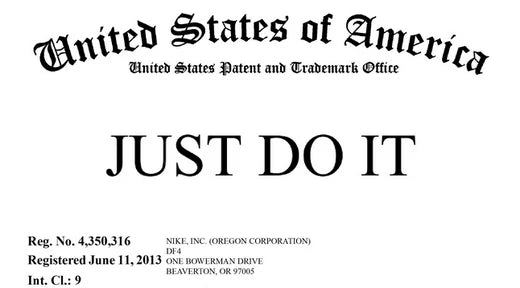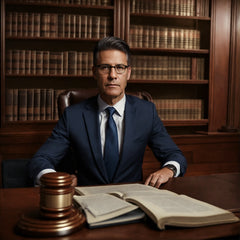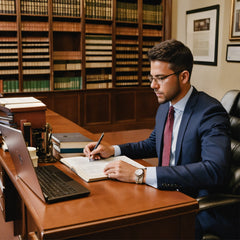Your cart is empty now.

How to Trademark a Slogan or Phrase: A Comprehensive Guide
- 13 April, 2024
- Nyall Engfield
How to Trademark a Slogan: A Comprehensive Guide
A slogan is a short, catchy phrase used by a business or organization to identify a product or service and distinguish it from those of competitors. Trademarking a slogan or phrase can protect it from unauthorized use, enhance brand recognition, and ensure its exclusive rights. This guide will explore the steps to trademark a slogan, what is permitted and prohibited under trademark law, and any special considerations involved in the process.
One slogan that consistently ranks among the most recognizable and influential globally is Nike's "Just Do It." Introduced in 1988, "Just Do It" transcends the brand's sportswear identity to become a ubiquitous part of popular culture. It's a motivational phrase that resonates well beyond its original advertising context, encouraging individuals to push beyond their limits in all aspects of life. This slogan's widespread recognition and its ability to inspire action make it a strong contender for one of the world's most popular slogans.
Understanding Trademark Basics
A trademark is a sign capable of distinguishing the goods or services of one enterprise from those of other enterprises. Trademarks are protected by intellectual property rights that prevent others from using similar signs that could confuse consumers. Trademarks can include words, logos, symbols, and even slogans that represent a company or product.
Step-by-Step Guide to Trademarking a Slogan
1. Create a Unique Slogan: The first step in trademarking a slogan is to create one that is unique and distinctive. The more unique the slogan, the easier it is to protect. Generic, informational or commonly used phrases are typically not eligible for trademark protection.
2. Conduct a Trademark Search: Before applying for a trademark, conduct a thorough search to ensure your slogan isn't already in use or registered. This can be done through the United States Patent and Trademark Office (USPTO) online database, or through various international databases if you're considering protection outside the U.S.
3. Application Preparation and Filing: Once you've ensured your slogan is unique, prepare your trademark application. This includes identifying the precise goods or services it will be associated with and deciding whether to file under a specific class of goods or services. You may want to file the mark in all capitals which will cover you for use of the trademark in any case. You'll need to file your application with the appropriate trademark office, such as the USPTO in the United States.
4. Examination by the Trademark Office: After filing, a trademark examiner will review your application to ensure it meets all legal requirements. This includes checking for conflicts with existing trademarks and ensuring that the slogan is distinctive enough to qualify for trademark protection.
5. Respond to Office Actions: If the examiner has any objections, they will issue an Office Action. You must respond to this, often with legal arguments, within a set period. Failure to respond adequately can result in the application being abandoned. If you receive an office action you can often argue the merits of the application through a trademark attorney.
6. Publication for Opposition: If the examiner's concerns are resolved, the slogan will be published in the Official Gazette. This allows the public and other businesses to oppose the registration if they believe it infringes on their rights.
7. Registration: If no opposition is filed or if opposition is overcome, the trademark office will register the slogan. You will receive a certificate of registration, affirming the legal protection of your slogan.
What is Permitted and Prohibited in Trademarking a Slogan?
Permitted:
- Distinctive and unique slogans: Slogans that are inherently distinctive or have acquired distinctiveness through extensive use in commerce can be trademarked.
- Descriptive slogans: If they have acquired secondary meaning, meaning consumers associate the slogan specifically with your product or service. This typically means more than five years' use or extensive advertising of the slogan.
Prohibited:
- Generic phrases: Common phrases or terms that are widely used and informational phrases cannot be trademarked as they do not identify the source of goods or services.
- Descriptive terms without secondary meaning: Slogans that merely describe the product or service without indicating its source.
- Offensive or deceptive marks: Slogans that are immoral, deceptive, or scandalous are also barred from trademark protection.
Avoiding the dreaded Commonplace Expression objection
Here's what you need to know about the commonplace expression objection for trademark slogans:
- The USPTO may deny registration to slogans on the ground that they fail to function as a trademark because they are merely informational, commonplace terms, messages, or expressions widely used by various sources
- A slogan is considered commonplace if it is a widely used concept or sentiment that merely conveys an ordinary, familiar, well-recognized concept or sentiment. Examples include common terms of affection or sentiment about a place, like "TEXAS LOVE"
- To determine if a slogan is commonplace, the USPTO will look for evidence of widespread use of the phrase or similar variations by third parties, particularly on similar goods or services. They may consider online search results, websites, and other uses in the marketplace
- Merely adding a geographic term like a state or city name to a common expression of sentiment is unlikely to overcome the commonplace objection, as seen in the "TEXAS LOVE" example
- To avoid the commonplace expression objection, the key is to create a unique and distinctive slogan that is not already in widespread use by others. The more unique and creative the slogan, the easier it will be to protect
- Conducting a thorough trademark search before applying can help identify potential conflicts or similar phrases already in use. If the slogan appears to be widely used by others, it may be best to go back to the drawing board.
- If a slogan has been refused as commonplace, it may be possible to overcome the objection by submitting evidence that the slogan has acquired distinctiveness or secondary meaning through extensive use and promotion. However, this can be a high bar to meet.
- Consulting with a trademark attorney can be helpful in evaluating the strength of a proposed slogan, conducting searches, and crafting arguments to overcome potential objections
In summary, to avoid the commonplace expression objection, it's crucial to create a distinctive, creative slogan that is not already in widespread use by others. Conducting thorough searches and consulting with legal counsel can help identify potential issues early on and develop strategies to overcome objections if they arise.
Examples of Famous Slogans
Here are 10 examples of famous slogans:
- Nike: "Just do it." - This iconic slogan captures Nike's message of motivation and action in just three words.
- Apple: "Think different." - Apple's thought-provoking slogan challenges the status quo and inspires creativity and individuality
- McDonald's: "I'm lovin' it." - McDonald's catchy slogan is recognizable, simple, and resonates with customers
- L'Oréal: "Because you're worth it." - L'Oréal's empowering slogan celebrates self-worth and has endured for 50 years
- De Beers: "A diamond is forever." - This timeless slogan associates diamonds with enduring value and relationships
- Disneyland: "The happiest place on Earth." - Disneyland's slogan encapsulates the magical and joyful essence of the theme park experience
- Maybelline: "Maybe she's born with it. Maybe it's Maybelline." - Maybelline's slogan playfully suggests that their products enhance natural beauty
- KFC: "Finger lickin' good." - KFC's straightforward slogan highlights the deliciousness of their food in a memorable way
- Coca-Cola: "Open happiness." - Coca-Cola's uplifting slogan evokes positive emotions and joyful experiences associated with their brand
- Subway: "Eat fresh." - Subway's simple two-word slogan emphasizes the freshness and healthiness of their sandwiches
These famous slogans demonstrate the power of concise, memorable phrases that capture a brand's essence, evoke emotions, and resonate with target audiences.
Special Considerations
International Protection: If you intend to use your slogan outside the United States, consider applying for protection in those countries as well. This can be done through the Madrid Protocol, which allows for international registration based on a U.S. application or registration.
Use in Commerce: For a slogan to maintain its trademark protection, it must be used continuously in commerce. If it is not used for a prolonged period, it may be considered abandoned.
Renewal Requirements: Trademark registrations are not indefinite; they must be renewed periodically. In the U.S., for example, a trademark must be renewed every 10 years and after the first 5.5 years.
Legal Counsel: Given the complexities and legal nuances involved in trademark law, consulting with an intellectual property attorney can be advantageous. They can help navigate the application process, respond to Office Actions, and provide advice on maintaining and enforcing trademark rights.
Trademarking a slogan involves careful planning and consideration, from ensuring the slogan’s uniqueness to navigating the application process and responding to potential opposition. By securing a trademark for a slogan, businesses can protect an essential element of their brand identity, preventing others from using similar phrases that could confuse customers and dilute the brand's impact. Always consider consulting with a legal professional to ensure that the slogan meets all criteria for trademark protection and to navigate any potential legal challenges effectively.
Search
Archive
- January 2026



